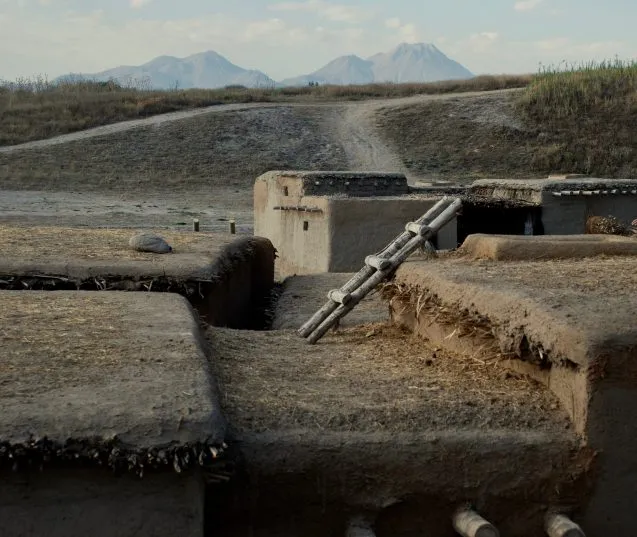Ancient Urine Reveals Timeline of Turkey’s Agricultural Revolution
Researchers studied urine salt deposits to map out the history of animal domestication at Turkey’s Aşıklı Höyük settlement
/https://tf-cmsv2-smithsonianmag-media.s3.amazonaws.com/filer/06/1e/061e708f-0469-4656-abf3-89e54ce30798/western_section_duru-637x425.jpg)
Traces of urine left by humans and domesticated animals who lived in central Turkey’s Aşıklı Höyük settlement some 10,000 years ago are helping archaeologists rewrite the timeline of early agriculture, a new study published in Science Advances reports.
As Richard A. Lovett explains for Cosmos, researchers led by Jordan Abell of Columbia University’s Earth Institute drew on urine salt deposits found in layers of sediment at the Neolithic village to estimate Aşıklı Höyük’s sheep and goat population between its peak years of 8450 B.C. to 7450 B.C.
Based on 113 soil samples analyzed for ions commonly associated with the bodily fluid, as well as high levels of nitrogen isotopes linked with animal waste, the team concluded that an average of 1,790 people and animals peed—and lived—on the site daily over the course of its 1,000-year history. To further narrow down this figure, the scientists compared ancient urine salt levels to those of modern test subjects, and took into account the amount of salt deposited by rain or ash rather than urine.
Although the scientists were unable to differentiate between human and animal urine using this method, Science magazine’s Angus Chen notes that they did subtract estimated human waste, as evidenced by the number of excavated homes found in a given sediment layer, from the total concentration of urine salts to gauge roughly how many sheeps or goats were present at a given time.
According to New Atlas’ Michael Irving, Aşıklı Höyük’s salt levels began rising between 10,400 to 10,000 years ago, when humans first started settling the area. Between 10,000 to 9,700 years ago, salts spiked to levels around 1,000 times higher than previously recorded, matching theorized population growth and burgeoning animal domestication. At its height, the settlement’s population density was roughly one individual or animal for every 10 square meters, or 108 square feet.
Crucially, Becky Little writes for History.com, these findings—indicative of a rapid transition from hunting and gathering to farming and herding—support the increasingly popular theory that agriculture emerged across multiple locations at the same time rather than beginning in the Fertile Crescent and spreading outward from there.

As Abell says in a press release, the data suggests that Aşıklı Höyük shifted from hunting sheep and goats to herding them on a small scale, operating on larger-scale management and finally keeping the high number of animals in corrals at the periphery of the village. This timeline, Abell adds, “may [offer] new evidence for a more rapid transition” to domestication.
Researchers have long used remnants of ancient poop to map out the stories of bygone civilizations, but the study’s authors believe they are the first to conduct similar research with urine, or more specifically, salts that speak to, in Abell’s words, the “development of animal management.”
Traces of urine hold one key advantage over bones, Benjamin Arbuckle, an anthropologist at the University of North Carolina at Chapel Hill who was not involved in the new research, tells the Atlantic’s Sarah Zhang: “It’s really hard to tell if they’re being hunted or if they’re being herded or if some of them are being hunted and some are being herded,” he explains, adding that high levels of urine found in a single location can be more easily linked with animals and people’s long-term presence.
It’s worth noting, Canan Çakirlar, a zooarchaeologist at the University of Groningen who was not involved in the study, tells Zhang, that while “very promising,” the technique does not necessarily account for chemical changes in urine deposits over time. Given that ancient humans and livestock had different diets than their modern counterparts, it’s possible their urine contained different salt concentrations.
Moving forward, the team behind the Science Advances paper hopes to refine its method, figure out a way to differentiate between human and animal salt deposits, and, as Abell tells Cosmos’ Lovett, highlight the potential of sediment oft-ignored in favor of seemingly more significant artifacts.
“The sediments between these larger objects have largely been ignored,” Abell concludes. “I am hopeful that our study will aid in bringing attention to the potential of applying geochemical techniques to these sediments.”
/https://tf-cmsv2-smithsonianmag-media.s3.amazonaws.com/accounts/headshot/mellon.png)
/https://tf-cmsv2-smithsonianmag-media.s3.amazonaws.com/accounts/headshot/mellon.png)